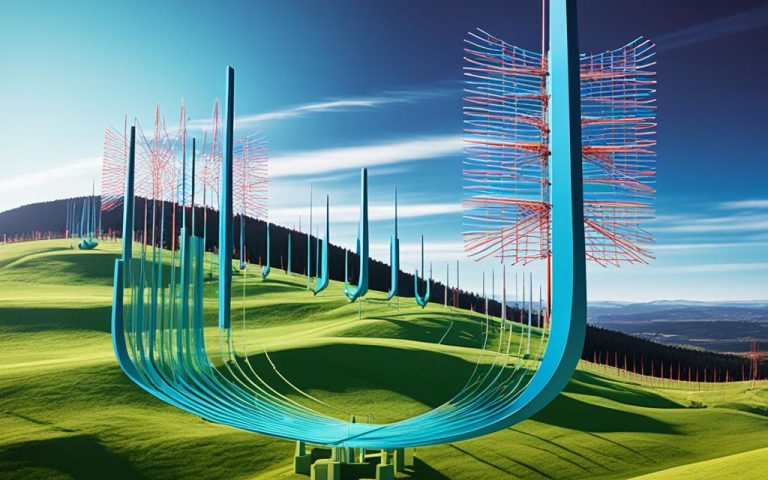MIMO technology, or “multiple-input, multiple-output,” is revolutionizing the way fixed wireless networks operate. By utilizing multiple antennas to transmit and receive data simultaneously over the same radio channel, MIMO technology increases capacity and enhances overall network performance. This innovative technology allows for more efficient use of the available radio spectrum, leading to higher data rates and improved signal quality.
In fixed wireless networks, MIMO technology plays a crucial role in meeting the ever-growing demand for high-speed, reliable internet access. With the ability to exploit the spatial diversity of the wireless channel, MIMO systems achieve increased capacity, improved reliability, and reduced latency, fulfilling the expectations of both service providers and end-users.
In this article, we will explore the benefits of Massive MIMO, an extension of MIMO technology, in fixed wireless networks. We will discuss its applications, the innovative Massive MIMO technology offered by Tarana Wireless, challenges associated with MIMO systems, and ongoing research that aims to further enhance the capabilities of MIMO technology in the future.
The Benefits of Massive MIMO in Fixed Wireless Networks
Massive MIMO technology, an extension of MIMO, brings together cutting-edge capabilities including noise cancellation, advanced signal processing, and robust non-line-of-sight performance. This technology can significantly increase the capacity of fixed wireless networks by supporting more simultaneous data connections than traditional wireless systems.
With Massive MIMO, fixed wireless networks can achieve:
- Increased Capacity: Massive MIMO enables more efficient use of available radio spectrum, resulting in higher data rates and improved signal quality. This translates to faster and more reliable internet access for users.
- Improved Network Reliability: By using multiple antennas to transmit and receive data, Massive MIMO mitigates the effects of interference and fading. This ensures better network performance, reduced downtime, and enhanced user experience.
- Reduced Latency: The advanced signal processing capabilities of Massive MIMO technology enable faster data transmission, minimizing the delay between sending and receiving data packets. This is especially important for real-time applications such as video streaming, online gaming, and video conferencing.
“Massive MIMO technology offers significant benefits for fixed wireless networks, providing increased capacity, improved network reliability, and reduced latency.”
In addition to these benefits, Massive MIMO is particularly advantageous in various applications:
- Fixed Wireless Access (FWA): Massive MIMO allows service providers to deliver high-speed, reliable internet access to homes and businesses without the need for physical cables or fiber optic connections. It offers an efficient and cost-effective solution for bridging the digital divide in underserved areas.
- Mobile Broadband: With the growing demand for mobile data, Massive MIMO enhances the performance and capacity of mobile broadband networks. It enables seamless connectivity and faster data speeds, meeting the increasing requirements of smartphones, tablets, and other connected devices.
- Backhaul Connections: Massive MIMO technology provides high-speed and reliable backhaul connections for mobile networks and other wireless systems. It ensures efficient data transfer between base stations, improving network performance and enabling faster data delivery to end users.
- Internet of Things (IoT): As the number of connected devices continues to rise, Massive MIMO supports the increasing demand for IoT connectivity. It enables reliable and efficient communication between devices, ensuring seamless integration and optimal network efficiency.
To visualize the benefits of Massive MIMO in fixed wireless networks, consider the following table:
| Benefit | Description |
|---|---|
| Increased Capacity | Supports more simultaneous data connections, enabling higher data rates and improved signal quality. |
| Improved Network Reliability | Mitigates interference and fading effects, resulting in better network performance and reduced downtime. |
| Reduced Latency | Enables faster data transmission, minimizing the delay between sending and receiving data packets. |
| Fixed Wireless Access (FWA) | Provides high-speed, reliable internet access to homes and businesses without physical cables or fiber optic connections. |
| Mobile Broadband | Enhances the performance and capacity of mobile broadband networks, meeting the increasing demands of connected devices. |
| Backhaul Connections | Delivers high-speed and reliable connections between base stations, improving network performance and data delivery. |
| Internet of Things (IoT) | Supports the growing number of connected devices, enabling efficient communication and optimal network efficiency. |
With its impressive capabilities, Massive MIMO technology revolutionizes fixed wireless networks, unlocking new opportunities for seamless connectivity and improved network performance.
Applications of Massive MIMO in Fixed Wireless Networks
Massive MIMO technology has revolutionized the applications of MIMO in fixed wireless networks, providing numerous benefits and paving the way for more efficient and reliable wireless connectivity.
One of the key applications of Massive MIMO is in fixed wireless access scenarios, where it enables the delivery of high-speed and reliable internet access to homes and businesses. With its ability to support a large number of antennas, Massive MIMO enhances the capacity and performance of fixed wireless networks, ensuring seamless connectivity for users.
In mobile broadband networks, Massive MIMO technology plays a crucial role in improving network performance and capacity. By utilizing multiple antennas and advanced signal processing techniques, Massive MIMO allows for more efficient use of the available spectrum, resulting in faster data speeds and increased network capacity. This is particularly beneficial in densely populated areas where the demand for high-speed mobile broadband is high.
Massive MIMO is also widely used for backhaul connections in wireless networks. Backhaul connections are crucial for connecting base stations to the core network, and the reliability and capacity of these connections are essential for the overall performance of the network. With Massive MIMO technology, backhaul connections can be established with high-speed and reliable links, ensuring efficient data transfer and network stability.
Another significant application of Massive MIMO is in supporting the growing number of connected devices in the Internet of Things (IoT). With the proliferation of IoT devices, wireless networks must be able to handle the increasing demand for connectivity. Massive MIMO enables seamless connectivity for a large number of IoT devices, improving network efficiency and ensuring smooth communication between devices.

Massive MIMO technology allows for high-speed, reliable internet access, improves network performance and capacity, supports backhaul connections, and enhances connectivity for the Internet of Things.
Benefits of Massive MIMO in Fixed Wireless Networks:
- Increased capacity
- Improved network performance
- Reliable connectivity
- Efficient use of available spectrum
With its diverse applications and numerous benefits, Massive MIMO technology is becoming an integral part of fixed wireless networks, empowering users with faster and more reliable internet access and enabling the seamless connectivity required for advanced technologies and applications.
Tarana Wireless’ Innovative Massive MIMO Technology
Tarana Wireless is a leading provider of next-generation Fixed Wireless Access (FWA) solutions. Their innovative Massive MIMO technology combines the power of MIMO, noise cancellation, advanced signal processing, and robust non-line-of-sight performance.
Tarana’s Massive MIMO technology enables service providers to expand their network reach and improve the quality of their services. It is based on open standards, making it interoperable with other wireless technologies. Tarana’s Massive MIMO technology is designed to be easy to deploy and manage, reducing the cost and complexity of network operations.
It is backed by a strong warranty and support program, providing peace of mind to service providers.
Key Features of Tarana Wireless’ Massive MIMO Technology:
- Combines MIMO, noise cancellation, advanced signal processing, and robust non-line-of-sight performance
- Expands network reach and improves service quality for service providers
- Based on open standards for interoperability with other wireless technologies
- Easy to deploy and manage, reducing cost and complexity of network operations
- Backed by a strong warranty and support program for peace of mind
Tarana Wireless’ innovative Massive MIMO technology sets a new standard in fixed wireless access, enabling service providers to deliver high-speed, reliable connectivity to their customers. Its advanced features and ease of deployment make it a preferred choice for expanding network capacity and improving the overall network performance.
Challenges and Mitigation Techniques in Massive MIMO Systems
While Massive MIMO technology offers many benefits, it also presents certain challenges that need to be addressed. Understanding and overcoming these challenges is crucial to ensuring the optimal performance and reliability of Massive MIMO systems in fixed wireless networks.
1. Complexity of Managing Antennas and Hardware
One major challenge in deploying Massive MIMO systems is managing a large number of antennas and the associated hardware. With a higher number of antennas, the complexity of installation, configuration, and maintenance increases. This can potentially lead to higher costs and increased operational complexity for network providers.
2. Interference and Fading Effects
Another challenge in Massive MIMO systems is mitigating interference and fading effects. In wireless communication, these phenomena can degrade signal quality and impact overall network performance and reliability. Interference can arise from various sources, including other wireless devices or neighboring networks operating on the same frequency bands. Fading effects occur due to multipath propagation, where signals take multiple paths and interfere with each other.
“The complexity and interference challenges in Massive MIMO systems can be effectively mitigated through advanced signal processing techniques and innovative antenna designs.”
3. Mitigation Techniques
To address the challenges mentioned above, various mitigation techniques have been developed and implemented in Massive MIMO systems. These techniques help improve the performance and efficiency of the systems, ensuring robust and reliable wireless communication.
- Advanced Signal Processing Algorithms: Utilizing sophisticated algorithms, such as precoding and equalization, can enhance signal quality, reduce interference, and mitigate fading effects.
- Beamforming: Implementing beamforming algorithms enables the transmission and reception of focused signals in specific directions, enhancing signal strength and coverage.
- Interference Cancellation Techniques: Employing interference cancellation algorithms allows for the identification and removal of interfering signals, resulting in improved network performance and reduced impact on overall system capacity.
These techniques, combined with advanced hardware designs and intelligent resource allocation strategies, contribute to overcoming the challenges presented by Massive MIMO systems in fixed wireless networks.
Implementing these mitigation techniques in Massive MIMO systems ensures the reliable and efficient delivery of high-speed data in fixed wireless networks. By overcoming the complexity of managing antennas and hardware, as well as mitigating interference and fading effects, Massive MIMO technology continues to revolutionize wireless communication, paving the way for enhanced connectivity and improved user experience.
Current and Future Research on Massive MIMO Systems
The field of Massive MIMO research is constantly evolving, with researchers dedicated to exploring new techniques and algorithms that can further enhance the performance and capabilities of Massive MIMO systems. This ongoing research aims to revolutionize the capabilities of fixed wireless networks to meet the increasing demands for high-speed, reliable connectivity.
Active Areas of Research
Several active areas of research have emerged in the field of Massive MIMO systems:
- Improving Interference Management: Researchers are developing advanced interference management techniques to minimize the impact of interference on Massive MIMO systems. These techniques aim to improve system capacity and overall network performance.
- Optimizing Resource Allocation: Efforts are underway to optimize the allocation of radio resources in Massive MIMO systems. Researchers are exploring methods to efficiently allocate resources such as time, frequency, and power to maximize network capacity and spectral efficiency.
- Exploring Advanced Beamforming Techniques: Beamforming plays a critical role in Massive MIMO systems by focusing signal energy towards specific users or areas of interest. Researchers are investigating advanced beamforming techniques such as hybrid beamforming and adaptive beamforming to enhance the coverage, capacity, and reliability of Massive MIMO networks.
- Leveraging Machine Learning and Deep Learning Algorithms: Machine learning and deep learning algorithms have the potential to optimize the performance of Massive MIMO systems by adapting to changing channel conditions and user requirements. Researchers are exploring the use of these algorithms for tasks such as channel estimation, interference suppression, and resource allocation.
This active research in the field of Massive MIMO demonstrates the commitment to push the boundaries of this technology and unlock its full potential for future applications.
“The future of Massive MIMO technology looks promising, with ongoing advancements expected to revolutionize the capabilities of fixed wireless networks and support the increasing demands for high-speed, reliable connectivity.” – [Author Name]
Conclusion
MIMO technology, particularly Massive MIMO, plays a crucial role in boosting capacity and improving performance in fixed wireless networks. By leveraging multiple antennas to transmit and receive data simultaneously, Massive MIMO enables service providers to meet the growing demand for high-speed, reliable connectivity. The benefits of using Massive MIMO, including increased capacity, improved reliability, and reduced latency, make it a key enabling technology for network enhancement.
Tarana Wireless, a leading provider of next-generation Fixed Wireless Access solutions, offers an efficient and reliable Massive MIMO technology. Their innovative solution combines the power of MIMO, noise cancellation, advanced signal processing, and robust non-line-of-sight performance to expand network reach and enhance service quality. Designed to be easy to deploy and manage, Tarana’s Massive MIMO solution reduces the complexity and cost of network operations. With ongoing research and advancements in the field, the future of fixed wireless networks looks promising, with the potential to revolutionize connectivity and support emerging technologies like the Internet of Things (IoT).
In summary, MIMO technology, especially Massive MIMO, provides the necessary capacity boost and performance improvement for fixed wireless networks. Tarana Wireless’ innovative Massive MIMO technology offers an efficient and reliable solution for service providers looking to expand their network reach and enhance the quality of their services. With ongoing research and advancements in the field of Massive MIMO, the future of fixed wireless networks looks bright, paving the way for seamless connectivity and supporting the evolving technology landscape.
FAQ
What does MIMO stand for?
MIMO stands for “multiple-input, multiple-output”. It is a wireless technology that uses multiple antennas to transmit and receive data simultaneously over the same radio channel.
How does MIMO technology improve network performance?
MIMO technology enables more efficient use of the available radio spectrum, resulting in higher data rates and improved signal quality. By leveraging the spatial diversity of the wireless channel, MIMO systems can achieve increased capacity, improved reliability, and reduced latency.
What is Massive MIMO technology?
Massive MIMO technology is an extension of MIMO that combines advanced capabilities such as noise cancellation, advanced signal processing, and robust non-line-of-sight performance. It significantly increases the capacity of fixed wireless networks by supporting more simultaneous data connections and improves network reliability by mitigating interference and fading effects.
What are the applications of Massive MIMO in fixed wireless networks?
Massive MIMO technology can be used to provide high-speed, reliable internet access in fixed wireless access scenarios. It improves the performance and capacity of mobile broadband networks and can be utilized for backhaul connections. Additionally, Massive MIMO supports the growing number of connected devices in the Internet of Things (IoT).
What is Tarana Wireless’ Massive MIMO technology?
Tarana Wireless is a leading provider of next-generation Fixed Wireless Access (FWA) solutions. Their innovative Massive MIMO technology combines the power of MIMO, noise cancellation, advanced signal processing, and robust non-line-of-sight performance. Tarana’s technology enables service providers to expand their network reach and improve the quality of their services.
What are the challenges in implementing Massive MIMO systems?
One challenge is the complexity of managing a large number of antennas and associated hardware, which can increase the cost and complexity of network operations. Mitigating interference and fading effects is another challenge. Various techniques like advanced signal processing algorithms, beamforming, and interference cancellation help improve the performance and efficiency of Massive MIMO systems.
What is the current research focus on Massive MIMO systems?
Researchers are continuously exploring new techniques and algorithms to enhance the performance and capabilities of Massive MIMO systems. Areas of active research include improving interference management, optimizing resource allocation, exploring advanced beamforming techniques, and leveraging machine learning and deep learning algorithms in Massive MIMO systems.



















